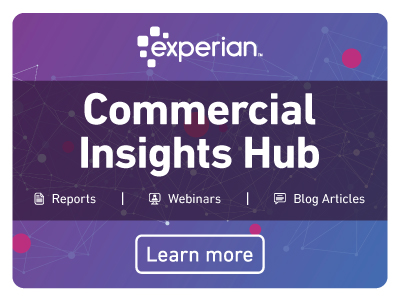All posts by Gary Stockton
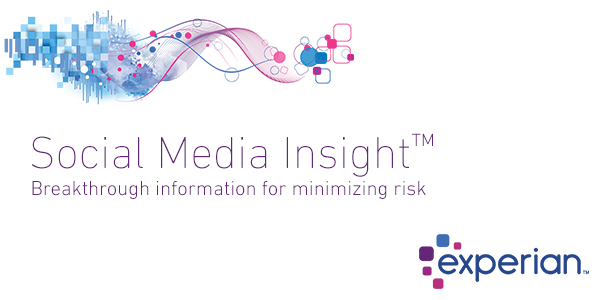
For lenders, alternative data can be the factor in edging out your competitors, especially when better decisions are needed to compete for emerging businesses and startups. Both startups and emerging businesses may represent a good growth opportunity, but they may also be high risk. The challenge? Businesses with thin credit profiles can be difficult to score. Social Media Insight TM provides lenders with another layer of data that can help you better assess the direction of these businesses, score them more accurately and open new growth opportunities. After all, nobody likes to leave money on the table. For emerging businesses who have a thin credit profile but have a strong social media reputation, Social Media Insight can be a factor in gaining access to credit and resources they deserve. Social Media Insight enables you to see the activity, trends and sentiment on a business, over time. In our Experian DataLab tests, we improved overall model performance by 12 percent and new and emerging businesses by 91 percent, boosting predictive performance over traditional data sets. Social Media Insight is directly sourced data providing you with over 70 attributes including trends and sentiment along with descriptive attributes. This powerful data enables you to more accurately score or assess new and emerging business as well as long established accounts. Want to learn more? Watch our on-demand webinar or contact your Experian representative today.

All business customers are not created equal. Even companies that look solid at first glance can hide festering problems that eventually can impact your bottom line. Successful credit management requires you to carefully evaluate the financial health of every business that asks for credit terms. Here are 5 questions you should be able to answer before extending business credit: 1. Is the business what it claims to be? Sometimes, companies needing credit will provide inaccurate information to win approval. Before opening an account, you need to confirm the applicant‘s bona fides, including its location, size, number of employees, annual revenue, years of operation and similar financial indicators. 2. What is its payment history? Although past performance does not guarantee future results, a company’s payment history is often a strong indicator of how it is likely to behave in the future. Pulling a business' credit report can easily provide you a snapshot of a company's payment history as well as other risk measures. 3. Are there hidden factors that could affect its ability to pay? Are there pending judgments, lawsuits, bankruptcies, regulatory citations or other “red flags” that could make it difficult for the applicant to meet its obligations in the future? This is another area where a business' credit report will be a key factor in helping you uncover a potentially risky business. 4. How much credit should you extend? All credit contains an element of risk, but you can mitigate that risk by limiting the amount of credit you extend based on factors such as the customer’s sales volume, debt to-asset ratio and similar aspects. 5. Under what terms should you extend credit to this customer? You can mitigate risk further by carefully calibrating the combination of interest rates, minimum payments and other contract terms based on each customer’s individual financial metrics.
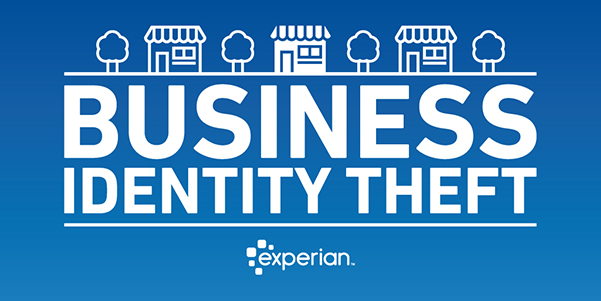
You likely go to great lengths to protect your own identity from fraud and theft. But are you actively protecting your business’s identity as well? Even more importantly, do you make sure you are not doing business with fraudulent companies that have been victims of identity theft themselves? In many ways it’s harder to protect your business identity than your consumer identity. Information about most businesses is publicly available – and as easy to find as a simple Google search. Because businesses self-report much of their own information, it’s easy for a thief to add their name or address to a company. To make it even easier, many businesses do not protect their EIN the same way as they secure their SSN – which they should. At first glance, you may think having your personal identity stolen to be more damaging than a business identity. But in fact, the opposite is often true. Business owners often personally guarantee loans, even if the loan turns out to be fraudulent. And then if a business must close its doors due to the losses from the theft, the business owner now has no income and must repay the loan. How Business Identity Theft Happens Some thieves steal business identities by purchasing a shell corporation. Others take over a company’s data. But regardless of how the left happens, the criminals often go to great lengths to mirror the company. Some even rent space in the same building as the original company and using the same suppliers. At this point, the fraudulent company can start physically intercepting deliveries as well as applying for loans and credit, posing as the original company. Criminals start with one piece of information that is real, such as an address or EIN number. And then start operating as if they are the company and changing the data. Criminals often wait patiently while building up their reputation and credit history, then “bust out” with a large amount of fraudulent activity in a short period of time, and then walk away before they are discovered. Protect Your Own Business Identity Business owners must constantly monitor their business information to spot red flags that criminals have taken over. The earlier the theft is discovered, the less damage that occurs. Here are three things to look for to spot business identity theft of your own business: Look for new addresses added. Check your credit reports and government filings to verify the address. One of the first signs of theft is often a new address added to your business information. Verify that new registered owners have not been added. Thieves will often add a new principal — CEO, owner or partner — to the list of owners. The criminals can then conduct business as if they are an owner. Check business accounts daily. Use online banking — which also reduces the risk of stolen paper statements — to look for any transactions that you or your employees did not make. Consider setting mobile alerts for suspicious transactions to spot issues even faster. Verify Your Customers are Not Fraudulent Companies Before doing business with a company, do a business verification by making sure the company is who they say they are and not a and not a fraudulent company. Since verifications cost time and money, take each customer on a case-by-case basis regarding how deep to dig. If a customer orders $100,000 worth of computer equipment, you should do a more thorough investigation than for a business ordering a single $500 laptop. However, anytime you are extending a line of credit to a company, you should deep dive into a companies' history and data because you are taking on a high risk. Stacking loans is a common tactic – meaning companies take loans from multiple companies at the same time. Because many companies often verify customers by looking at their relationship with the business, they are verifying in a vacuum instead of seeing the entire picture. By using databases and tools that provide a holistic view of all activity, it becomes much easier to find the fraud. Here are five things to look for when verifying a company: Verify the EIN number. One scheme is to use a different EIN number and have all other pieces of information the same. Make sure the company you are doing business with is using the same EIN number as the legitimate company. Consider the number of open lines of credit. Because fraudulent companies often open multiple lines of credit at the same time, determine the current amount of open credit. Multiple large lines opened around the same time can be a red flag. Look at the number of sub-companies and activity between the companies. Criminals often set up a fraud ring by operating as sub companies underneath a single company. The “companies” then loan money to each other to boost credit scores and credibility. Note for periods of dormancy. When a business identity is first stolen, the criminals set up the company and then go dormant to build credibility through age. The company will then “bust out” by making a lot of transactions very quickly with multiple companies. Look for additional addresses. Check to see if the address you have been given is the same as the company’s headquarters. Multiple similar addresses can be a red flag. As business identity theft continues to rise, you must keep your eyes open for signs of theft — both with customers and your own business. A single credit check or google search simply isn’t enough. You owe it to your business and your future.
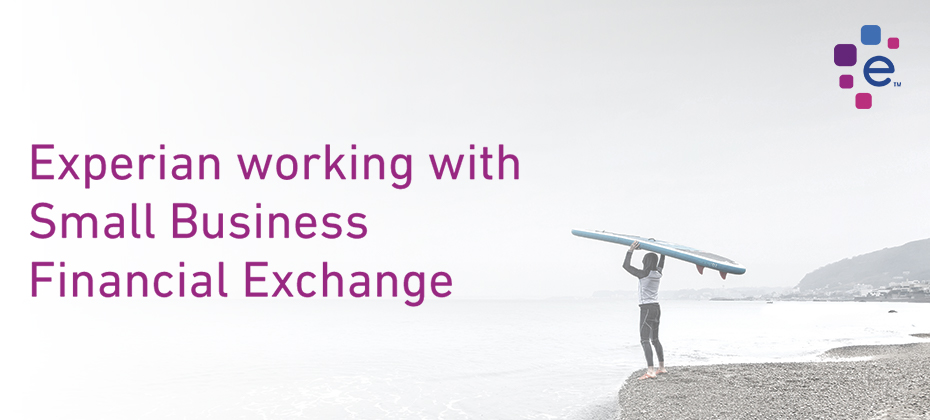
Scottsdale, Ariz., May 22, 2018 — Experian®, at its 37th annual Vision Conference, today announced it has become a certified vendor of the Small Business Financial Exchange, Inc. (SBFE), a nonprofit trade association that gathers and aggregates small-business payment data in the United States to help organizations build a complete picture of small business. “We’re excited to work with SBFE, which shares our mission to bring further innovation to the small-business credit landscape,” said Hiq Lee, president, Experian Business Information Services. “By combining the SBFE’s data richness with Experian’s vast consumer and commercial data assets and leading data science capabilities, we will use the power of data to help our clients make the right decisions.” As a SBFE Certified Vendor, Experian can combine its rich data — including traditional and alternative business data and consumer data on business owners — with SBFE’s data to provide the most comprehensive view of a small business in the market today. For example, financial institutions looking for broad and deep insights on small and emerging businesses will be able to find that information in a way no one has offered previously. Also for the first time, Experian clients that are nonfinancial institutions, such as e-commerce, communications, insurers, and software and hardware vendors, can qualify to access this financial data to help them make confident credit decisions by gaining deep visibility into a small business’s capital use and credit history through Experian. “Experian becoming an SBFE Certified Vendor makes perfect sense in support of our ongoing mission to serve our Members and the small-business community,” said Carolyn Hardin-Levine, CEO, SBFE. “Experian demonstrated its ability to meet SBFE’s high data security and governance requirements, controls, and independent oversight requirements. Additionally, Experian’s ability to deliver blended solutions combined with SBFE data will provide our Members with more options and drive innovation as part of SBFE’s single-feed, multicertified vendor model.” New product pipeline Experian fosters a culture of continuous innovation, from the way it works to the solutions it creates. The company plans to deploy its data scientists to apply leading-edge techniques, including machine learning and artificial intelligence, to discover and provide predictive insights and analytical tools to support better decisioning for its clients. It is anticipated that the work of its data scientists on the combined data sets will result in new product launches over the next 24 months. Vision Conference Each year, Vision combines in-depth research, cutting-edge technology and expertise from industry leaders to help Experian’s clients strengthen their balance sheets and plan for sustained growth. The 2018 conference sold out and runs May 20–23 in Scottsdale, Ariz. Contact: Jackie Brenne Experian Public Relations 1 714 830 5126 Jackie.Brenne@experian.com About Experian Experian is the world’s leading global information services company. During life’s big moments – from buying a home or a car, to sending a child to college, to growing a business by connecting with new customers – we empower consumers and our clients to manage their data with confidence. We help individuals to take financial control and access financial services, businesses to make smarter decisions and thrive, lenders to lend more responsibly, and organisations to prevent identity fraud and crime. We have 16,500 people operating across 39 countries and every day we’re investing in new technologies, talented people and innovation to help all our clients maximise every opportunity. We are listed on the London Stock Exchange (EXPN) and are a constituent of the FTSE 100 Index. Learn more at www.experianplc.com or visit our global content hub at our global news blog for the latest news and insights from the Group. About SBFE The Small Business Financial Exchange, Inc., and SBFE, LLC (collectively known as SBFE) is the country’s leading source of small-business credit information. Established in 2001, this nonprofit association’s database houses information on more than 32 million businesses and enables information exchange among members who provide small-business financing. Through its resources and relationships, SBFE makes possible innovative risk management solutions by providing industry insight and analysis of aggregated small-business financial data to its Members. SBFE is the only Member-controlled organization of its type and is serving as the most trusted advocate for the safe and secure growth of small business. For more information, visit www.sbfe.org.
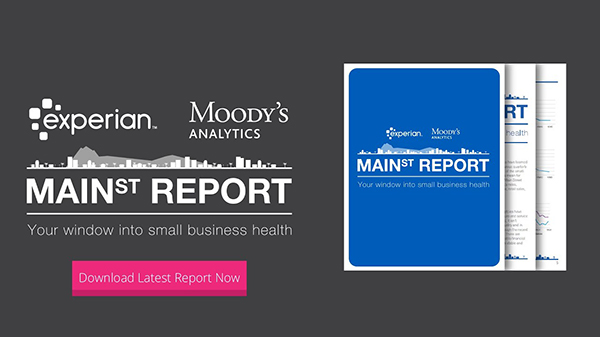
Today Experian Business Information Services releases the Experian/Moody's Analytics Main Street Report for Q1 2018. The report brings deep insight into the overall financial well-being of the small-business landscape, as well as providing commentary around what certain trends mean for credit grantors and the small-business community. Q1 2018 saw credit conditions loosening and balances rising as more businesses access credit. The report states the overall outlook for small-business credit is positive. Delinquencies were down and default rates rose slightly, suggesting that credit conditions have peaked as the economy is in a late-cycle expansion. Continuing strength in the macroeconomy will keep small-business credit moving in the near term, along with higher profits from the recently passed tax legislation. Small-business credit will be less certain in the medium to long term as rising wages, interest rates and changes to the tax code take a toll. Download the latest report
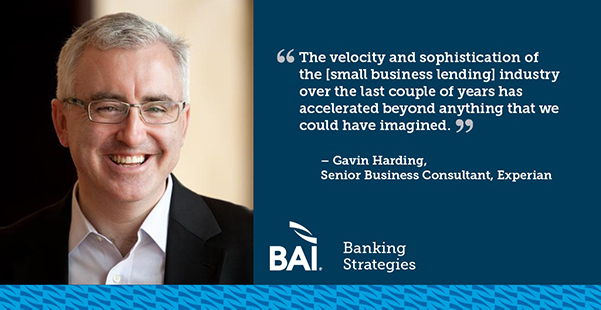
Click image to play the podcast This episode of the BIA Banking Strategies podcast was originally published on BAI Banking Strategies website. [Lou Carlozo]: For small businesses in 2018 the signs and indicators are complex. Bankruptcies are up, but credit conditions have finally shifted for the better. Some remain battle scarred and debt averse from the Great Recession. Yet, others see this as a time to aggressively pursue growth. How can banks make sense of these signs and take advantage of the times? To find out we'll talk with Gavin Harding Senior Business Consultant with Experian. [Lou Carlozo]: Welcome to BAI Banking Strategies where each week we'll focus on the key issues facing financial services leaders. We'll bring you objective opinions and actionable insights that will help you power smart decisions. I'm your host, Lou Carlozo, the managing editor of BAI, come on in. Don't miss our immersive annual event BAI Beacon which takes place in Orlando Florida October 9th through 11th. It takes a team to transform an organization and each team member has their own area of expertise that's critical to the effort. In the BAI Beacon, you can find the topics most relevant to your individual role and regroup at the end of the day with fresh perspective and ideas. Save 50 percent when you register before May 31. To find out more visit www.bai.org/baibeacon. [Lou Carlozo]: Thanks again for tuning into the podcast. It is great to have you here with us. And today on the program we have Gavin Harding the Senior Business Consultant with Experian Decision Analytics Global Consulting Practice. For more than half of his career Gavin held senior leadership positions with a large regional bank gaining experience in commercial and small business strategy, SBA lending, credit and risk management and sales. Gavin great to have you on the podcast today. [Gavin Harding]: Good to be here Lou. Thank you for inviting me. [Lou Carlozo]: Experian in conjunction with Moody's Analytics has this new report out the Main Street Report. Your window into small business health. So are small businesses healthy right now? [Gavin Harding]: Small businesses are very healthy right now. When you think of a small business's performance you think of it two ways one is in terms of you know revenue and overall health, and the other is in terms of access to credit how they pay their bills? For our purposes today we're thinking more about it from a lending banking perspective. From that perspective, bankruptcies are low and have been low for several quarters. Delinquencies are low and have been low for several quarters. So the fundamentals of small business are very robust very strong. [Lou Carlozo]: Small businesses are enjoying a great time. That doesn't mean of course that they're not without challenges and I'm going to read a portion of the report. Bankruptcies continued to rise in the fourth quarter making 2017 a full year in which bankruptcies increased every quarter. Taken alone this isn't good news but bankruptcies are coming off historical lows. Give us a little bit more insight as to what is going on here? [Gavin Harding]: Sure, so let's go back in time a little bit to the dreaded year 2008 when the world pretty much ended in financial terms. Massive turmoil. We tightened up credit. The whole industry worked through a series of losses. After a couple of years those portfolios were pretty well cleared out. So what was left was decent solid businesses with good fundamentals and a lot of the weak players had been essentially weeded out of the market. So time goes on, small businesses slowly start to invest but they were very leery of taking on a lot of debt but they had made it through the war. So those businesses had good credit performance. They were paying their bills and that went on for several years, and for I think it was 14 quarters. We saw that those small businesses continued to pay on time, continued to be good stewards. And then we get to 2017. [Lou Carlozo]: And then what? [Gavin Harding]: So in 2017 there was a lot of change. There had been limited investment from small business for a long time, and there is only so long that you can wait to invest. There comes a point when equipment breaks, when you need to hire people. Businesses became more optimistic. Lenders, bankers, fintech's started to open up the credit box a little bit broader standard. For 14 quarters we saw that those small businesses continued to pay on time, continued to be good stewards in terms of their investment. Good performance, very low bankruptcy levels, and then they really start to get a little optimistic a little confident, money starts to flow. We would expect that delinquencies would increase a little bit over time. We would expect that low bankruptcy rate to increase. So my perspective on that is that while it is something we should keep an eye on. It's very much an indication of growth, of confidence, of enthusiasm and investment. [Lou Carlozo]: What do you see as the most important context heading forward? [Gavin Harding]: The single most common question we have been asked over the last 18 to 24 months is when is it going to turn? And of course if we knew when it was going to turn I would be a retired multibillionaire. So the best we can do is look for indications right? and when we look for indications we look for those on a macro level, unemployment, and as we approach and reach full employment what does it do to wage growth? What does it do to access the human capital? And then we also look at it on a more micro level which is you know within our portfolio what are we seeing that's going to give us that hint? So if we start seeing instead of a gentle upward trend that we might think about in terms of a return to normality, if we start seeing for instance in our credit card portfolios for small businesses, those delinquencies spike, if we start to see those cards maxed out and delinquencies increase, that could be one of those very early signs. The other thing just keep in mind is this, the industry and when I say the industry I'm thinking about finance, over the last couple of years, has transformed in many ways. We all need to have a digital presence. We need to engage customers when they want to communicate with us. And when we need to do that with the products that they're looking for, and at the same time as we deliver this in a very slick quick way we have to maintain good solid robust risk management. And at the same time as we do all of that, we've got to make sure the fraudsters are held at bay and we minimize identity fraud and other types of fraud. So the whole industry has accelerated, it's very much now about digital technology. Customers are looking for quick and ready access. That opens all kinds of other risks for us. We're talking about integrated fraud risk. We are talking about you know advanced analytics on the portfolio. We are talking about operational risk, and our favorite kind of risk, regulatory risk, as we work to comply with regulations that are new and still evolving and haven't been tested yet. So it really is the velocity and sophistication of the industry over the last couple of years has just accelerated beyond anything I think we could have imagined. [Lou Carlozo]: I think the other consequence of this is clients sometimes getting jittery, getting nervous and one of the things that you specialize in is getting into those situations when things don't go as smoothly as a client might like, and offering some remediation, some help keeping things calm and moving forward. Tell us a little bit about how you do that work because you do it so well. [Gavin Harding]: We have clients that have either been in business a long time, or are relatively new to the space and there's often a common feature in the feature is, that they have grown many times grown rapidly, and what they had in place at the beginning was augmented and there was lots of other stuff bolted on. Prime example, banking client, regional bank, 67 separate systems and applications, none of which spoke to each other are connected. So you've got that rapid growth. You hit a certain kind of critical mass and you have to make the decision and the decision is are you going to stop assess, and identify a better way of doing things, and address all of these legacy systems and reports and legacy data and routines and processes? So in many cases working with clients we're able to stand back because we're outside right. We're outside, we know the industry, we've worked with a lot of clients but because we aren't involved in those processes day to day, we can look at them with a cold eye. We can assess them objectively against some of what we've seen other successful clients do. And in many cases, take heavily manual paper based processes and reports and decision making, and make it a lot more efficient, and by efficient, I don't mean you know automatic approvals I don't mean artificial intelligence. I mean old fashioned efficiency. So instead of doing something in ten steps can you do it in three. And when you take that analysis and you spread it across commercial lending for example, or through small business lending, there are some real opportunities to transform the process, to transform the experience of the people that have to work within the process, and ultimately to improve turnaround and accuracy the customer experience itself. [Lou Carlozo]: Turnaround accuracy. I would say this the banks and financial institutions are very fortunate to have you on their side. Gavin I want to thank you for making the time to be on the podcast today it was a real privilege. [Gavin Harding]: My pleasure. Thank you. [Lou Carlozo]: Gavin Harding is a Senior Business Consultant with Experian Decisions Analytics Global Consulting Practice. You can look for Gavin on LinkedIn. And here are three key takeaways from today's podcast: Bankruptcies are up for small businesses. In fact for four consecutive quarters in 2017 according to the Experian report. But that deserves a long view, post-recession. The small businesses that survived became very debt averse while banks tightened up lending. For small and medium sized businesses 2017 also marked a turning point to address needs such as replacing worn out equipment, or hiring badly needed staff. Some businesses haven't made it but it's nothing like the recession and it's a wave of doom. For small businesses in 2018 the news remains very positive, fundamentals are strong. Full employment is here, but there will always be potential storm clouds to keep an eye on. One is credit card delinquency spikes, another, moving too fast to address risks such as fraud. Businesses that have experienced rapid growth often suffer from bolted on systems and unconnected applications. In this case rapid growth means slowing it down. It comes down to four steps, stop, assess, identify and address. The endgame, find and implement efficiencies. [Lou Carlozo]: And now BAI Banking Strategies brings you the aha moment where our podcast guest shines a light on that point in time where realization revelation or exploration made all the difference in their financial services career. Now sometimes before you climb a mountain you've got to dig a hole and here Gavin Harding recalls how a visit from a federal regulator taught him a humbling lesson that he carries with him to this day. Listen. [Gavin Harding]: So let me take you back to Philadelphia in 1999. Being young and educated I was absolutely sure for a certainty that I knew pretty much everything I needed to know. And into that office walked a Federal Reserve auditor. He asked me a series of questions which I immediately answered, and over the course of an hour I dug a hole maybe 20 feet wide by 30 feet deep. Nice straight sides and I climbed on down into it. It took seven weeks and hundreds of files to undo the damage I did with reacting, with feeling, feeling that there had to be an answer that would be an answer now. With feeling that, as an executive, I had to have the answers. So my lesson from that experience and I keep it with me every day and it is part of every interaction with clients. First pause, and then clarify. So make room to think, understand that I didn't have to give an answer. Understand that "I'll get back to you" was a much better answer than a whole series of statements that may or may not have been connected, and were not thought out and were not researched. So I am greatly appreciative to the Federal Reserve for training me in 1999 in Philadelphia. This episode of the BIA Banking Strategies podcast was originally published on BAI Banking Strategies.
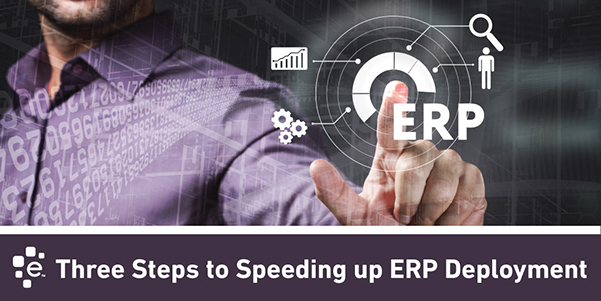
Your company is dependent on many different people — customers to buy products, employees to provide excellent customer service, and vendors to provide services. However, it can be challenging to have an accurate picture of all aspects of vendor relationships. By having clean and connected vendor data, you can more quickly deploy Enterprise Resource Planning (ERP) software. Challenges of Knowing Your Dependency on a Single Vendor Because departments often make their own vendor contracts — hardware, services, office supplies — the relationships are typically not stored in one place and often are in siloed databases. Human resources, marketing and product development could all have independent contracts with the same cloud-software provider for file sharing, and not be aware of the other relationships. It becomes even more confusing because vendor contracts for the same company may have different addresses for satellite locations. Human error also comes into play with typos in addresses and company name spelling mistakes. Companies may merge with each other. Or an office may move to a new location. This makes it challenging, if not impossible, to see a clear picture of your entire relationship with each vendor. Why Vendor Dependency Matters When you know your dependency on a vendor, you can understand your risk and better negotiate volume discounts. If a vendor that provides 45 percent of the materials needed to manufacture a specific product runs into supply issues or is facing serious financial issues, your company knows the impact from the start and can make alternate plans. You can also contact the cloud-software provider used by three departments and ask for preferred pricing based on an accurate number of users. If a vendor is also a customer, knowing your dependency lets you assess the balance of trade between the two companies, meaning how much you buy from the company compared to how much the company purchases from you. Correct vendor profiles are also essential for successfully using ERP. If the vendors are not connected or inaccurate data is imported, the ERP cannot show all relevant data for an organization in one place. You must start the ERP process with clean and connected data for ERP to improve the efficiency of your business and its resources. Otherwise, the deployment process takes longer, and you won’t get all the available benefits an ERP provides. Three steps to preparing vendor data for ERP deployment: 1) Clean your data. You must first clean your data for a consistent view of vendors across all files. Manually going through vendor files would be exceptionally time consuming and error-prone. By using Experian data and technology, you can quickly use databases of company information to correct errors and other issues in the data. 2) Enrich data for an accurate view of relationships. The next step is linking the businesses together across files and departments using a single unique Identifier. Experian’s Business Identification Number (BIN) product, makes this process accurate and quick. Your company can then see a real-time view of current and past orders with each supplier. You can also add additional data, such as credit scores and other supplier-related data. 3) Create a company hierarchy. Even though all the contracts are technically with a single company, departments may be working with a specific division or location for their services. This becomes important if divisions are sold or reorganized. By using a tool, such as Experian’s Corporate Linkage product, you can link the companies into a corporate hierarchy to provide an even clearer view of the relationships. Start getting ready for using ERP software by cleaning, enriching and linking vendor data. The next time you see a vendor mentioned on the news — data breach, bankruptcy, scandal — you don’t have to wonder what it means for your company. With a few clicks, you’ll know your dependency and can start planning. To learn how Experian can help you clean, enhance and link vendor data to speed up ERP deployment, visit www.experian.com.
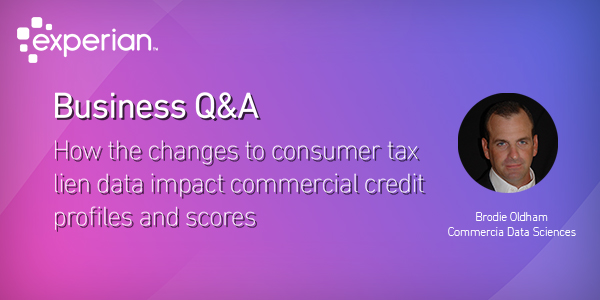
Last year the three primary credit bureaus; Experian, Equifax, and TransUnion announced and implemented enhanced standards for the collection and timely updating of public record data reported on consumer credit reports. This was done in accordance with the National Consumer Assistance Plan requirements. Part of this work involved the partial removal of tax lien data from our consumer credit reporting database. With the complete removal of remaining tax lien data scheduled for April 16th, some of our clients have asked how these changes might impact commercial credit reports. In this business Q&A I ask Brodie Oldham for some clarification. What is NCAP and how did it impact Experian's core credit data? Brodie Oldham: Gary the NCAP is the National Consumer Assistance Plan and it was put in place by the three U.S. credit reporting agencies Experian, Equifax and TransUnion in response to the U.S. attorney general's request for clarity and transparency in consumer credit data. The data that was the main focus was data that did not meet completeness or freshness requirements of data furnishers to the credit reporting agencies. The data that had the most impact from the study was public record data; judgments and liens for consumers that weren't updated or didn't have all of the personal identifying data necessary to meet the guidelines. This data is planned to be removed in April of 2018. Was there impact to Experian's commercial credit data? Brodie Oldham: No Gary not an impact to our commercial credit data collected at Experian. We continue to collect that public record information for use in evaluating small businesses through our commercial credit scores. The impact with the public record information is really when we're evaluating a business owner guarantor using the consumer credit information where public record data has been removed. What was the impact to commercial blended scores? Brodie Oldham: The impact is when we're evaluating small business owners or guarantors using their consumer credit information. When we look at segments where commercial-only data is used there is no impact there because we're not changing the way that we collect public record information on the commercial side of our business?With the blended scores you would expect that if we remove some of the consumer derogatory information in public records that the score would go up. And we saw a mean lift to about .03 percent, so very small. In the performance of the blended generic credit scores in their evaluation and capture of those delinquent accounts. We saw a very insignificant lift, so the scores are very stable and working well even with the change that we're having with public records. Additional Resources: Whitepaper - NCAP Impact on BIS Scores (June-2017) National Consumer Assistance Plan Is Extended as Experian, Equifax and TransUnion Settle with State Attorneys General

Pew Research Center has stated that the Millennials are projected to be the largest generation by 2050. So with this in mind Experian examined the business credit trends of Millennial business owners to see how their behaviors might impact small business. The results of that research has been published in a new whitepaper titled "Millennial-owned small business — a fast growing segment." Andrea Schmalzer is the analyst who worked on the study and we asked her a few questions about the research in our latest Business Q&A. Gary Stockton: Can you tell us a little about the data set you analyzed for your study? Andrea Schmalzer: In this study what we did was we looked at small businesses during the year 2012 2015 and 2017. We then segmented the data by generation for millennials. We looked at anybody born between 1981 and the year 2000. Andrea Schmalzer: There are various ranges for defining millennials. However this is definitely within the standard range of the definition. Gary Stockton: In terms of small business. How large is the millennial segment today? Andrea Schmalzer: So the millennial segment is actually still a smaller segment of the business community at about 7 percent. But they are growing quite rapidly. Since 2012 they've grown about 92 percent in small businesses. Whereas if you look at the baby boomers they've only grown by 11 percent. So there's definitely substantial growth happening within the millennial-owned business area. Gary Stockton: What are the industries that millennials are most concentrated in? Andrea Schmalzer: So the millennials are concentrated in basically the same industries as all other generations.We do see about 44 percent of all small businesses owned by millennials in the services industries. So that can be anything from a nail salon to a medical doctor. We then have about 18 percent in retail trade. So that's any goods that you're going to be buying for personal use, and then about 12 percent are focused in on construction industries. Gary Stockton: Do millennials represent an opportunity for lenders? and if so, how? Andrea Schmalzer: Absolutely. What we're seeing is a really strong decreasing trend in delinquency rate for millennials? So back in 2012 we were seeing about 18 percent delinquency rates. Currently in 2017, what we're seeing is about 9 percent which is totally in line with all other generations? We're also noticing their business credit scores improving year over year. As well as their longevity. So by year 5 their business survival rate is stronger than any other generation. At this point it looks like the millennials are starting to figure out the way that businesses work, and how to use credit wisely. So there's definitely room for lenders to appeal to this segment. Download Report

